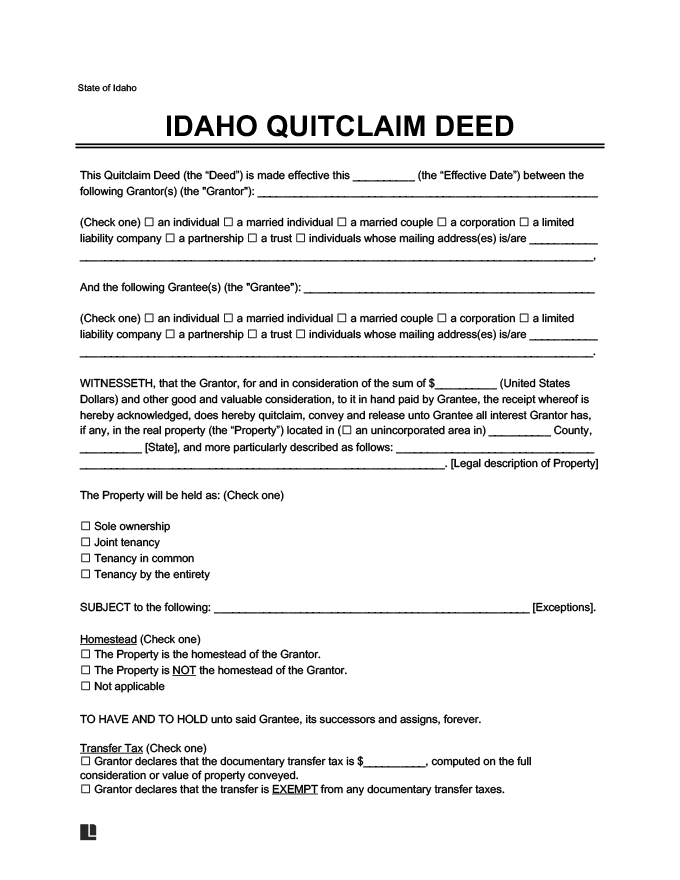In Idaho, residents use quitclaim deeds to transfer property from one person (the “grantor”) to another (the “grantee”). Unlike other transfer options in the state, quitclaims don’t include any “warranty of title.” This means that the grantor makes no formal promises that their claim to ownership of the property is complete, accurate, and clear of any defects.
This document represents a quicker and less complex option for gifting or transferring property among two parties that share a high level of trust.
Legal Framework
Idaho Statutes Title 55, Chapter 6 lays out all relevant state quitclaim deed requirements.
Legal Description
The legal description of the property should include “metes and bounds” such as:
- Section, township, and range.
- Subdivision.
- Each different tract, unit, or block.
If you run out of space to properly describe the property in full within the deed’s content section, a secondary document may be attached and referenced. For the secondary document, note information like the date registered, the book, the page, and the registration numbers on the deed.
Signing
- The grantor must sign before an authorized notary public who acknowledges the signature (§ 55-805).
- Both spouses must sign if the grantor is married or the property is registered as their homestead unless one spouse signs a spousal waiver of homestead rights that must be attached to the quitclaim at filing (§ 32-912).
Terminology
- The deed must specifically include the term “quitclaim” in the context that the grantor “quitclaims” the property to the grantee.
- The word “grants” implies warranty and should only be used in a deed that guarantees the grantor’s ownership, like a warranty or grant deed (§ 55-612).
Additional Documents
According to § 55-2504, a Residential Property Disclosure Statement must accompany quitclaim deeds, except in cases where:
- The transfer is between co-owners.
- The grantor is transferring property to a spouse or lineal descendant.
- The grantor is transferring property to a current or ex-spouse due to separation or divorce.
- The grantee lived on the property for at least one year.
- The grantor is a non-resident owner who inherited the property.
- One of the other scenarios laid out in § 55-2505 exists.
Filing
- Completed forms must be filed in the recorder’s office for the specific county where the property is located.
Validity Requirements
State statutes such as § 31-3205 and county processes have set forth a standardized format and system for properly recording quitclaim deeds. To support these processes and be considered legally valid, the document must:
- Be in English or accompanied by a certified translation.
- Use paper that is at maximum size 8.5 x 14 inches (legal size).
- Use a font that has a minimum size of 10 points.
- Use a text color that is dark and clearly reproducible.
- Leave a three-inch margin on the top of the first page for official use.
- Be signed by the grantor and notarized.
Content Requirements
§ 55-818 and § 31-2413 outline content requirements for quitclaim deeds.
- The title “Quitclaim” on the first page.
- The name and address of the grantor and grantee.
- The grantor’s marital status.
- The return name and address, which is usually the grantee, but can be anyone else of your choosing.
- The name of the person requesting recordation (§ 31-2410).
- The property address.
- The property’s homestead status (§ 55-1007).
- The property’s legal description including metes and bounds.
- A granting clause, which is a statement that describes the transfer.
- A consideration clause that states the value of the property and the amount of money exchanged for it.
Quitclaim Deeds vs. Other Property Transfer Methods
| Quitclaim Deed | While often easier to complete than other options, it offers less security to grantees than other options. This makes quitclaims a popular method for transactions between friends and family members but much less popular for use in a traditional real estate transaction. |
| General Warranty Deed | Provides much more security to the grantee than quitclaims. Within this type of deed, the grantor formally confirms that they own the property and have the legal right to transfer it to the new owner. They are often used in traditional real estate sales in the state. |
| Special Warranty Deed | This limited warranty deed gives the grantee less protection than a general one but more than a quitclaim. While a general warranty secures the property against any title defects over all time, this secures the property against claims occurring only during the grantor’s ownership. |
| Grant Deed | Since the word “grant” implies warranties of title, these types of deeds are considered similar to warranty deeds. The grantor promises that the title has not been “conveyed,” or transferred, prior to the current exchange, and that no “encumbrances,” or title issues, exist. |
